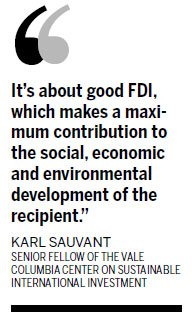Report shows coastal provinces get largest concentration of FDI
Updated: 2012-03-06 08:10
By Chen Weihua in New York (China Daily)
|
|||||||||||

For China's provincial leaders eager to woo overseas investors, a report released on Monday may provide some timely guidance.
Using the FDI Performance Index adopted by the United Nations Conference on Trade and Development to discover if areas have received FDI inflows appropriate to their economic power, the report reveals three provincial clusters, according to Karl Sauvant, senior fellow of the Vale Columbia Center on Sustainable International Investment.
The locations in the first cluster, all of which perform better than might be expected given their economic size, are virtually all coastal areas.
Led by the municipalities of Shanghai and Tianjin, and including provinces such as Liaoning, Jiangsu and Hainan, the first cluster contains nine of the top 11 performers. Chongqing in western China and Jiangxi in the central area are the only two non-coastal areas in the top 11.
Provinces in the middle cluster, mostly provinces in the western and central areas, are rated as underperforming. Meanwhile, provinces in the bottom cluster, which mainly comprises those wholly in the western regions, are underperforming significantly.
Even though the coastal region has been the best performer, its share of China's total FDI inflow declined to about 75 percent between 2007 and 2010 from 89 percent between 1987 and 1990.
Over the same period, FDI in the central region rose to roughly 17 percent from below 4 percent and that in the western region fluctuated, but was mainly lower than 10 percent.
Sauvant said the report should be of interest to provincial authorities, particularly to the agencies that offer investment promotion, as it provides a provincial performance comparison.
"In particular, they (the provinces) can explain their performance and what they intend do about it," said Sauvant, who co-authored the report with Chen Zhao, an associate of the National Committee on US-China Relations, and Xiaoying Huo, a research associate at the Vale Columbia Center.
According to Sauvant, there is a clear, if not strong, trend for FDI to move away from the coastal regions and toward the center. Yet the fact that the figures for the western region have not changed very much would suggest that more policy action is required.
"The question is whether more can be done," said Sauvant, acknowledging that things have improved in the western region since local governments took measures to improve infrastructure and education.
He suggested that the western regions should pair their investment promotion agencies with those from the coast. Companies in the coastal region are either moving labor-intensive production work out of China or are considering moving further inland.
He also suggested that provinces should appoint an investment ombudsman to resolve any problems and mediate between investors and the authorities.
Sauvant believes China will continue to be an attractive destination for FDI. "It may be less attractive for labor-intensive industries. But at the same time, given the improvement in infrastructure, skills and education, it will remain attractive for more advanced technology," he said.
"More importantly, as long as economic growth continues in China, it will be a very attractive location for investment," said Sauvant, a former director of UNCTAD's Division on Investment, Technology and Enterprise Development, which handles FDI within the UN system.
However, Sauvant emphasized that this does not mean the greater the amount of FDI, the better. "It's about good FDI, which makes a maximum contribution to the social, economic and environmental development of the recipient," he said.
Statistics show that the FDI inflow to China reached $116 billion in 2011, a rise of 9.7 percent over the previous year, although growth was slower than the 17.4 percent registered in 2010.
Analysts believe that the euro debt crisis, a weak recovery in the United States and China's new policies to discourage investment in the automobile and polysilicon industries may have a negative effect on FDI inflows to the country this year.
chenweihua@chinadailyusa.com
Today's Top News
President Xi confident in recovery from quake
H7N9 update: 104 cases, 21 deaths
Telecom workers restore links
Coal mine blast kills 18 in Jilin
Intl scholarship puts China on the map
More bird flu patients discharged
Gold loses sheen, but still a safe bet
US 'turns blind eye to human rights'
Hot Topics
Lunar probe , China growth forecasts, Emission rules get tougher, China seen through 'colored lens', International board,
Editor's Picks

|

|

|

|

|

|





